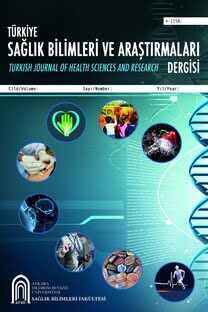Hekim Adaylarının, AIDS Kavramına İlişkin Algıları; Metafor Analizi Örneği ve Bilişsel Yapıları; Bağımsız Kelime İlişkilendirme Testi Örneği
Metafor, tıp öğrencisi, AIDS kavramı
Perceptions of Physician Candidates on AIDS Concept; Metaphore Analysis Example and Cognitive Structures of Physician Candidates; The Sample of Free Word Association Test
AIDS, Metaphor, Medical student,
___
- 1. Fitzpatrick R. Society and changing patterns of disease. In: Scambler G, ed. Sociology as applied to medicine, 6th ed. London:Saunders; 2008. p.3-18.
- 2. KRAHNKE H. AIDS’ten böyle korunurum 300 soru 300 yanıt. (Çev.A.Y. Namal). İstanbul: AIDS Savaşım Derneği; 1992.
- 3. STİNE, G.J. Acquired immune deficiency syndrome. New Jersey: Prentice Hall; 1996.
- 4. KÖKDEMİR, H. Turkish university students' blame attributions and attitudes toward people with AIDS. Ankara: Yayımlanmamış Yüksek Lisans Tezi, Orta Doğu Teknik Üniversitesi, Sosyal Bilimler Enstitüsü; 2001.
- 5. GREEN, C.J. HIV infection and AIDS. In: F.D. Monahan, J.K. Sands, M. Neighbors, J.F. Marek and C.J. Green (Eds.), Phipps' medical–surgical nursing. Health and illness perspectives Mosby: St. Louis, Missouri, USA; 2007.
- 6. SHIVELY, M., SMITH, T.L., BORMANN, J. and GIFFORD, A.L. Evaluating Self-Efficacy for HIV Disease Management Skills. AIDS and Behavior, 2002; 6(4): 371-379.
- 7. Abay Ş.E., Sezer B., Başusta N.B. Hekim Adaylarının Hekim Kimliğine İlişkin Algıları: Hacettepe Üniversitesi Tıp Fakültesi Metafor Analizi Örneği. Sürekli Tıp Eğitimi Dergisi 2017; 26 (1): 1-8.
- 8. Boelen C. The five-star doctor: an asset to heath care reform. Erişim adresi: http://www.who.int/entitmy/hrt/en/hrdj
- 9. Özvarış ŞB, Demirel Ö. Öğrenen merkezli tıp eğitimi eğitici rehberi. TTB ve Tıp Eğitimi ve Bilişimi AD., 2002 Haziran: 2.
- 10. Aslan D, Sayek İ. Tıp eğitimi içinde “uluslararası sağlık” yaklaşımı Hacettepe Tıp Dergisi 2005;36:135-138.
- 11.Watmough S, Waddelove C, Jaeger L. First year medical students’ perceptions of a career in medicine – How can these inform careers support? Constructing the future: Career guidance for changing contexts. Birmingham: Institute of Careers Guidance 2009.
- 12. Saban A. Öğretmen adaylarının öğrenci kavramına ilişkin sahip oldukları zihinsel imgeler. Türk Eğitim Bilimleri Dergisi 2013;1(7):281-326.
- 13. Arslan M, Bayrakçı M. Metaforik düşünme ve öğrenme yaklaşımının eğitim-öğretim açısından incelenmesi. Millî Eğitim Dergisi 2006;171:100-108.
- 14. Shuell TJ. Teaching and learning as problem solving. Theory into Practice 1990; 29(2):102-108.
- 15. Oxford RL, Tomlinson S, Barcelos A, Harrington C, Lavine RZ, Saleh A, Longhini A. Clashing metaphors about classroom teachers: toward a systematic typology for the language teaching field. System 1998;26(1):3-50.
- 16. Forceville C. The identification of target and source in pictorial metaphors. Journal of Pragmatics 2002; 34:1-14.
- 17. Leech NL, Onwuegbuzie AJ. A typology of mixed methods research designs. Qual Quant 2007; 43: 265–275.
- 18. COHEN, L., MANION, L. and MORRISON, K.. Research methods in education. 6th ed. New York, NY: Routledge; 2007.
- 19. KUŞ, E. Nicel-nitel araştırma teknikleri. Ankara: Anı Yayıncılık; 2003.
- 20. ÇİFTÇİ, S. Kelime çağrışımlarının cinsiyet değişkenine göre gösterdiği temel nitelikler üzerine bir deneme. Turkish Studies, . 2009;4 (3): 633-654.
- 21. ERCAN, F., TASDERE, A. and ERCAN, N. Observation of cognitive structure and conceptual changes through word association tests. Journal of Turkish Science Education, 2010; 7(2): 138-154.
- 22. ISIKLI, M., TASDERE, A. and GOZ, N.L. Investigation teacher candidates’ cognitive structure about principles of Ataturk through word association test. Usak University Journal of Social Science, 2011; 4 (1): 50-72.
- 23. ATASOY, B. Fen öğrenimi ve öğretimi: Ankara Asil Yayınevi; 2004.
- 24. BAHAR, M., JOHNSTONE, A. H. and HANSELL, M. H.. Revisiting learning difficulties in biology. Journal of Biological Education, 1999;33: 84- 86.
- 25. SATO, M. and JAMES, P. "Nature" and "Environment" as perceived by niversity students and their supervisors. International Journal of Environmental Education and Information, 1999;18 (2): 165-172.
- 26. Denzin NK, Lincoln YS. Collecting and interpreting qualitative material. Thousand Oaks, CA: Sage;1998.
- 27. Miles MB, Huberman AM. Qualitative data analysis. London: Sage;1994.
- 28. Silverman D. Doing qualitative research: a practical handbook. London: Sage;2000.
- 29.BILGIN, N. Content analysis techniques and case studies in social sciences. Ankara: Siyasal Publication;2006
- 30. LICHTMAN, M. Qualitative research in education. Los Angeles: Sage Publications, Inc.;2010.
- 31. LEBLEBİCİ, D.N. ve KILIÇ, M. İçerik analizi. Ankara: Hacettepe Üniversitesi Yayınları; 2004
- 32. Draper C, Louw G. What is medicine and what is doctor? Medical students’ perceptions and expectations of their academic and Professional career. Medical Teacher 2007;29(5):100-107.
- 33. KIRAGU, S.W. Exploring sexuality education and the burdened teacher: a participatory approach in a rural primary school in Kenya Pastoral Care in Education, .2007; 25 (3): 5-15.
- 34. KYRYCHENKO, P., KOHLER, C. and SATHİAKUMAR, N. Evaluation of a school-based HIV/AIDS educational intervention in Ukraine. Journal of Adolescent Health, 2006;39: 900-907.
- 35. Ekici G., Kurt H., Öğretmen Adaylarının ‘AIDS’ Kavramı Konusundaki Bilişsel Yapıları: Bağımsız Kelime İlişkilendirme Testi Örneği. Türkiye Sosyal Araştırmalar Dergisi. 2014 Aralık; 18(3).
- ISSN: 2651-3005
- Başlangıç: 2018
- Yayıncı: Ankara Yıldırım Beyazıt Üniversitesi
Pelin PİŞTAV AKMEŞE, Nilay KAYHAN, Gülce KİRAZLI, Fatih ÖĞÜT, Tayfun KİRAZLI
Günlük Yaşam ve Stres Yönetimi
Yasemin ÖZEL, Aysun BAY KARABULUT
Şenay ÜNAL, Birgül GENÇ, Sena KAPLAN, Birgül ÖZKAN
Vestibüler Hastalıklarda Koklear Semptomlar Ve Odyolojik Bulgular: Gözden Geçirme
Postürün Oral-Motor Yapılar Üzerine Etkisi
Tamamlayıcı ve Alternatif Tedavinin Jinekolojik Kanserlerde Kullanımı
Sibel PEKSOY, İlknur DEMİRHAN, Sena KAPLAN, Sevil ŞAHİN, Ayten ARIÖZ DÜZGÜN
Dilek ÖZTAŞ, Özgür ERDEM, Burak KURT, Muhsin AKBABA
Guillain-Barre Sendromuna Eşlik Eden İşitme Kaybı: Vaka Sunumu
Serpil ALLUŞOĞLU, Sevginar ÖNDER, Mehmet Fatih KARAKUŞ
Özel Hastane Yöneticilerinin Yalın Yönetime Yönelik Görüşleri; Ankara İli Örneği
Over Kanseri Tanısı Alan Bir Olguda Cinsel Sağlığın Değerlendirilmesi
